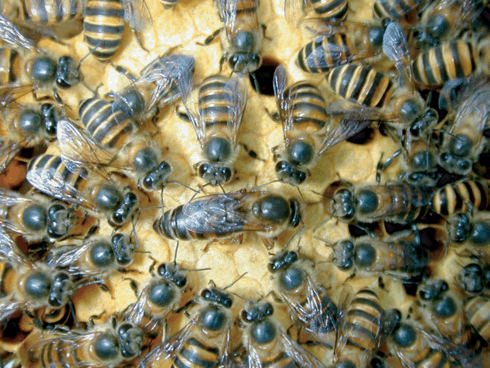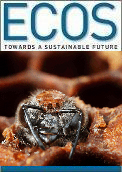
|
Published: 28 May 2012
Combating bee pollinator decline
With bee populations in decline internationally and the Australian arrival of the notorious Varroa destructor mite inevitable, ECOS looks at the challenges of protecting our pollinators.
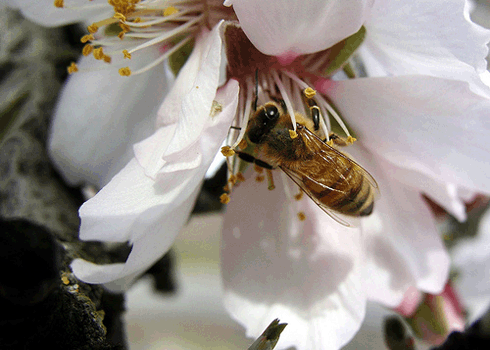
|
|
A honeybee on an almond flower. Some commercial orchards bring honeybee hives in at flowering time to increase pollination rates.
Credit:
Art Siegel
Rights: Licensed under a Creative Commons Attribution Non-Commercial License
|
In addition to honey, bees provide billions of dollars’ worth of pollination services to agriculture. But, during 2006–07, many United States beekeepers found their adult bees had vanished, stimulating global media interest and widespread reports of honeybee losses across North America and Europe.
While everything from mobile phone radiation and genetically modified crops to pests and diseases and the increasingly widespread use of pesticides has been blamed for the bees’ disappearance 1 , the cause of so-called colony collapse disorder (CCD) remains a mystery.
‘People talk about the bee decline as though they’re talking about one thing, but there are hundreds of species, and it’s important to distinguish between native species and honeybees – although these have feral populations as well,’ says Saul Cunningham, Biodiversity in Managed Landscapes Team Leader at CSIRO Ecosystem Sciences.
‘Globally, there are two distinct issues for honeybees [Apis mellifera],’ says Dr Cunningham. ‘Their decline is most closely linked to the Varroa destructor mite, but also to CCD.’
The drivers of wild (native) bee decline are different, he explains. They are more threatened by habitat destruction, land-use change and invasive species.
‘CCD is an expression of stress in a honeybee colony,’ says Dr Cunningham. ‘It is associated with already well-known bee diseases, but expresses itself as a collapse. It’s a bit like the ‘flu – many people get the ‘flu, but when people start dying from it, it’s a different matter.’
It is unclear whether CCD poses a similar problem in Australia and Dr Cunningham believes that the Varroa mite is the more potent threat to honeybees in Australia. Currently Australia is the only continent without Varroa. However, the mite’s arrival from New Zealand or Papua New Guinea is thought to be inevitable.
Varroa will pose new challenges for beekeepers. Miticides (chemicals applied to kill mites) used to combat the invading mites can further stress the colony, adding to concerns about agricultural insecticide use. Despite this, Dr Cunningham believes that beekeepers will adapt and use miticides in ways that minimise this threat.
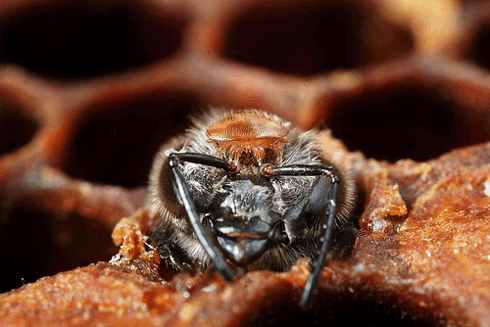
|
|
The parasitic mite Varroa destructor (adult female) on the head of its host: an emerging honeybee.
Credit:
Gilles San Martin
Rights: Licensed under a Creative Commons Attribution Share-Alike License
|
Apiarist Craig Scott is the Public Officer for the Crop Pollinators Association of Australia, and has been keeping bees commercially for more than 25 years. He says the industry needs to move away from alarmist rhetoric, and agrees that the Varroa mite is unlikely to wipe out all managed honeybees.
Like Dr Cunningham, Mr Scott believes that beekeepers will be able to manage the risks posed by Varroa.
‘It will require more day-to-day management of hives, but Varroa can be managed using a combination of plastic strips impregnated with miticide that are left in the hive for a set time, and natural methods like reducing the amount of brood [bee larvae and pupae], on which the mites depend for reproduction,’ explains Mr Scott.
‘If miticide guidelines are not correctly followed and the strips are left in the hive for longer than recommended, then the mites can become resistant and the bees then reproduce in a weakened environment.
‘Feral honeybees are a different matter. Scientists believe Varroa is likely to destroy feral colonies, which Australia has in very high densities, and which we currently heavily rely on for crop pollination services,’ says Dr Cunningham.
Even without Varroa, Australian beehive numbers have been in decline for more than a decade, thanks to the prolonged drought, competition from imported honey, hive beetle infestations, and the pressures imposed on beekeepers by the nomadic lifestyle associated with keeping bees commercially.
Mr Scott is concerned about the threat posed by the Asian honeybee incursion, which began in 2007.
‘[Asian honeybees] are a highly invasive species; they are the natural host for Varroa and other bee pests and diseases,’ he says. ‘They also steal stores from honeybee colonies, divide their hard to spot, teacup-sized colonies regularly, and spread quickly.’
Mr Scott also has deep reservations about the continued use of neonicotinoid pesticides, which are used to control insects on a wide variety of crops and in domestic gardens. There is some debate about their impact 2 . Many European nations have banned their use out of concern about their effects on bees.
‘Neonicotinoids are predominantly used as a seed dressing,’ he explains, ‘although in Australian stonefruit orchards, [they are] sprayed directly onto the plant.
‘There may be no impact from the initial crop, but subsequent crops are planted in the same soil and the residues are picked up by the plant. As bees move from crop to crop, they are exposed to more pesticides.’
Mr Scott says the neonicotinoid pesticides seem to affect neurotransmitters in the bees’ brains. ‘[The bees] get lost and don’t return to the hive. [The pesticide also] contaminates pollen that is fed to the brood, which then die, and weaken the hive overall.’
‘The big pesticide manufacturers say they can find no evidence of these problems,’ he says.
Dr Cunningham says that while pesticides are a concern, in general, Australian honeybees are in better shape than their northern hemisphere counterparts.
‘We don’t have such cold winters, and our bees are better fed, because they spend more time on native flora, which also reduces their exposure [to pesticides],’ he says.
The growth of managed pollination
Honey production was once the major proportion of a beekeeper’s income. But, in the past 10–15 years, the commercial pollination industry has grown: particularly for crops such as almonds, which are 100 per cent dependent on bee pollination.
If honeybee numbers fall dramatically – or even temporarily – food production will be threatened. Important crops such as canola, for example, produce 20 per cent more seeds if they are pollinated by bees.
‘Legumes, such as clover or lucerne, rely on honeybees for seed production and these are used as fodder for livestock,’ says Mr Scott.
With 1600 native bee species in Australia alone, could they step into the breach? Some community gardeners in Sydney think so. Native stingless bees flourish at the Asylum Seekers Centre community garden in Surry Hills. In response to requests from the community, the City of Sydney Council will be supplying native beehives to several community gardens later this year.
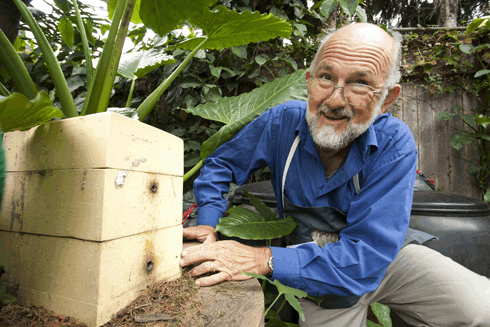
|
|
Apiarist Gavin Smith with a native stingless bee hive, at the Asylum Seekers Centre community garden in Surry Hills, Sydney. Credit:
Asylum Seekers Centre
|
‘Native bees are excellent pollinators of native plant species, but also crops like macadamias, mangoes, watermelons, lychees, citrus, strawberries, avocados and other vegetables,’ says City of Sydney Urban Ecology Manager, Katie Oxenham.
‘Their hives make an interesting feature in the garden,’ she says. ‘But, importantly, with many native beehives destroyed each year when hollow trees are cleared for development or safety reasons, urban beekeeping is doing its bit to maintain the pollination services [bees] provide.’
According to Dr Cunningham, international data shows that a lot of crops are pollinated by wild insects. ‘It is reasonable to expect that a diversity of pollinators can do a better job than any single species of bees,’ he says.
Current agricultural practices may, however, limit the effectiveness of wild bees.
‘We don’t know yet whether native bees are disappearing in Australia,’ says Dr Cunningham. ‘It is certainly a concern, given the extent to which landscapes have changed here. The reduced complexity of the agricultural landscape supports less diversity for native bees and poses great potential for decline.
‘While there may be more bees in a flowering canola field because it provides a giant injection of sugar in the landscape, it is on again–off again,’ Dr Cunningham explains. ‘There is greater diversity of bees in agricultural landscapes with patches of remnant non-agricultural land – such as weedy margins, roadside vegetation and stands of trees – because there is a year-round supply of resources.
‘The great majority of Australian bees are soil nesting, and undisturbed soil will provide [bees with] more opportunities than soil managed for agriculture.’
The buzz on natives
Katja Hogendoorn is a behavioural ecologist from the University of Adelaide. She has trialled native bees as pollinators on a range of crops, including blue-banded bees (Amegilla cingulataas) on commercial greenhouse tomatoes and related crops, and resin bees and leafcutter bees (both in the genus Megachile) on lucerne. Her findings indicate that native bees have great potential as crop pollinators.

|
|
Native blue-banded bee (Amegilla cingulataas) on a tomato flower.
Credit:
Katja Hogendoorn
|
‘Currently, commercially produced greenhouse tomatoes need to be pollinated by hand, because they require buzz pollination, which honeybees can’t do,’ Dr Hogendoorn explains.
‘Buzz pollination’ is pollination by resonant vibration. Bees grab onto the flower and move their flight muscles rapidly, making the flower’s anthers vibrate and dislodge pollen. Many plants, including tomatoes, are pollinated more efficiently by buzz pollination than by wind. In commercial greenhouses where wind is minimal, tomatoes are hand pollinated with industrial electric vibrating wands, incurring high labour costs.
‘Growers are keen to import bumblebees to do the work for them,’ says Dr Hogendoorn. ‘But an accidental release of bumblebees in Tasmania has already shown that they are highly invasive. They are also likely pollinators of weed species.
‘Blue-banded bees are just as good as bumblebees, and 10 per cent better than hand pollination, resulting in tomatoes with more seeds and better flavour,’ she says.
However, domesticating native bees is not without its challenges.
‘Getting them to breed in large numbers is tricky,’ Dr Hogendoorn explains. ‘They won’t take pollen from a dish, and need plants to feed their brood. If breeding was done in conjunction with tomato growers, it could be possible, but it’s not up to standard yet.
‘Also, we currently have greenhouses with open vents, small holes and other openings that allow the solitary bees to escape, meaning populations require constant renewal.
‘For these reasons, growers tend to prefer bumblebees, which are social [and therefore less likely to escape] and proven to work.’
Mr Scott is opposed the introduction of bumblebees, which pack a painful sting. Like Dr Hogendoorn, he sees a commercial role for native bee pollinators when used as an adjunct to an operating business, but says they will require a different management approach.
‘To maintain native bees for crop pollination, we may need to provide them with nesting opportunities,’ agrees Dr Hogendoorn. ‘And, if the bees are active at times when the crops are not in flower, planting suitable native vegetation in close proximity may help.
‘Fundamentally changing the way we use insecticides will also help encourage native bee pollinators, as many insecticides impact adversely on bees.’
More information
Pollinators in the landscape, CSIRO
1 Ratnieks et al. (2010) Clarity on honeybee collapse? Science 327(5962), 152–153.
2 Cresswell JE (2011) A meta-analysis of experiments testing the effects of a neonicotinoid insecticide (imidacloprid) on honey bees. Ecotoxicology 20(1), 149–157.


